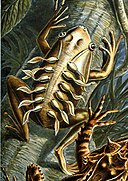Berkas:Haeckel Batrachia.jpg

Agengnyané pratuduh puniki: 424 × 599 piksel. Résolusi lianan: 170 × 240 piksel | 339 × 480 piksel | 543 × 768 piksel | 724 × 1.024 piksel | 2.323 × 3.284 piksel.
Berkas sujati (2.323x3.284 piksel, agengnyané berkas: 2,17 MB, soroh MIME:image/jpeg)
Babad berkas
Klik ring tanggal/galah anggén nyingakin berkas puniki ri tatkala galah punika.
| Tanggal/Galah | Gambar alit | Diménsi | Sang anganggé | Panampen | |
|---|---|---|---|---|---|
| mangkin | 24 Pébruari 2006 11.17 |  | 2.323 × 3.284 (2,17 MB) | Ragesoss | improve version, based on same original scan |
| 11 Pébruari 2006 08.22 |  | 2.318 × 3.280 (2,21 MB) | Ragesoss | The 68th plate from Ernst Haeckel's 1899 ''Kunstformen der Natur'', depicting frogs classified as Batrachia. Category:Ernst Haeckel |
Panganggén berkas
Kaca nganggén berkas puniki:
Panganggén berkas ring jagat
Wiki lianan ring sor puniki nganggén berkas puniki:
- Panganggén ring arz.wikipedia.org
- Panganggén ring ast.wikipedia.org
- Panganggén ring az.wikipedia.org
- Panganggén ring be.wikipedia.org
- Panganggén ring bg.wikipedia.org
- Panganggén ring ca.wikipedia.org
- Panganggén ring ca.wikibooks.org
- Panganggén ring ceb.wikipedia.org
- Panganggén ring ckb.wikipedia.org
- Panganggén ring dag.wikipedia.org
- Panganggén ring de.wikipedia.org
- Panganggén ring din.wikipedia.org
- Panganggén ring el.wikipedia.org
- Panganggén ring en.wikipedia.org
- Wikipedia:Featured pictures thumbs/04
- Wikipedia:Picture of the day/June 2006
- User:Ragesoss/Haeckel
- Wikipedia:Featured picture candidates/Haeckel Batrachia.jpg
- Wikipedia:Wikipedia Signpost/2006-03-13/Features and admins
- Wikipedia:Featured picture candidates/March-2006
- Talk:Frog/Archive 3
- User talk:Ragesoss/Archive1
- Wikipedia:Picture of the day/June 12, 2006
- Wikipedia:POTD/June 12, 2006
- Wikipedia:POTD column/June 12, 2006
- Wikipedia:POTD row/June 12, 2006
- Kunstformen der Natur
- User:Samsara/Frog/Stable
- User:RichardF/POTD
- Wikipedia:WikiProject Germany/Gallery
- User talk:RichardF
- User:Froggyyes~enwiki
- Wikipedia:Featured pictures/Animals/Amphibians
- Unclean spirit
- User:Xophist/s5
- Wikipedia:Wikipedia Signpost/2006-03-13/SPV
- Portal:Amphibians
- Talk:Alfred Russel Wallace/Archive 1
- Portal:Amphibians/Selected picture
- User:The Transhumanist/Sandbox144
Cingak panganggén sajagaté sané lianan saking berkas puniki.






